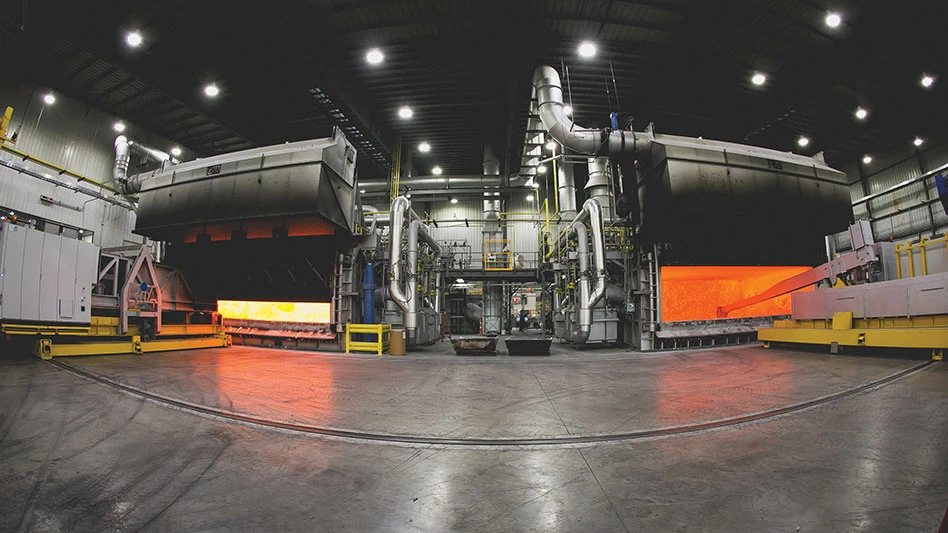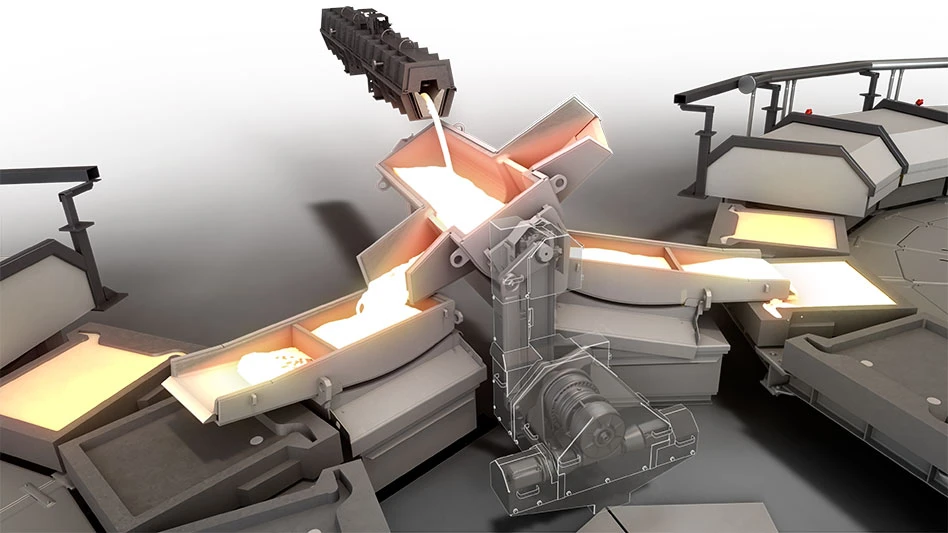Green building principles are slowly catching on among the architectural and contracting communities. With an emphasis on sustainability not only in the final building but throughout the design and construction process, these buildings often incorporate recycled materials, involve recycling during the construction process and promote energy efficiency as a means of reducing the strain on local infrastructure.
In addition to the subtle influence that green building is having on building materials selection, other factors are also influencing commercial and residential construction throughout the country and affecting types of materials in demand.
SECTOR TRENDS. Ken Simonson, chief economist for the Associated General Contractors, Alexandria, Va., says he is predicting that commercial building will outpace residential building this year. "I have to preface that by saying that I have predicted the same thing for the three and a half years that I’ve been here and was pleasantly surprised at how low interest rates have stayed and by how robust home building has been."
According to studies by the Cleveland-area based Freedonia Group, an international business research company, this reversal in building sector fortunes is expected to continue through 2008. "The office, lodging and industrial segments are each expected to post strong annual gains as a continuing economic expansion generates a more favorable environment for forward-looking expenditures by businesses," Freedonia Group predicts.
The company also forecasts positive indications in manufacturing construction. "A rebound in capacity spending will boost demand for manufacturing facilities, although the rapid growth will still leave the inflation-adjusted level of construction spending in 2008 below that of 1993."
When it comes to the commercial sector, Simonson says that consumers should continue buying, and lucky for the construction industry, they continue to change the stores they’re buying from, spurring new construction.
"Customers are fickle and they have been abandoning the malls and are going to the big-box stores," he says. "Those chains have been expanding."
However, Simonson says that malls are attempting to lure shoppers back into their establishments and that their efforts sometimes involve remodeling, providing shoppers with better access to individual stores. "I don’t know if that will work for the malls, but at least it’s generating some rebuilding activity for construction firms."
Simonson also says that the growth of "lifestyle centers," in which retail shops are combined with other amenities, from restaurants to entertainment venues to hotels to offices to residences, will spur commercial building activity.
Despite growing consumer appetites, warehouse construction has been on the decline in light of the just-in-time approach to inventory.
"I think there has been a real long-term shift in the economy away from inventory, and that has had negative implications for the warehouse sector in that neither retailers nor manufacturers are keeping as much inventory on hand," Simonson says.
He adds that the big chains are building large distribution centers to replace smaller distribution centers.
MATERIAL AVAILABILITY. In terms of construction materials, steel figures importantly into the construction of big-box stores.
"In terms of the materials used in big-box stores, I think there is quite a continuum between the really bare-bones warehouse store that is probably substantially steel and a store like Target, which some people say fits into the big-box definition," Simonson says, adding that Target stores use more of a traditional department store mix of materials.
As far as steel availability and pricing going into 2005, Simonson says a variety of opinions exist. "It is true that supply is increasing, both domestically and abroad," he says, "but demand is also growing."
China’s affect on the market also remains uncertain at this point.
"No one knows if China will be a net importer [of steel] again this year as they were in 2003, or if they have expanded their steel capacity enough and slowed down their construction and other demand enough that they will turn back to being an exporter, in which case there will be tremendous downward pressure on steel prices," Simonson says. "Surely there is going to be volatility this year, but whether we wind up the year with higher or lower steel prices, I don’t have a clear sense yet."
Simonson says he expects to see more upward pressure on cement than in the past. "U.S. cement capacity has been growing rather slowly, and we rely on imports for 20 [percent] to 25 percent of our cement," he says. "Shipping capacity was a problem last year, and that may be an issue now, particularly because tsunami relief will be tying up some of the bulk ships that otherwise could be bringing cement or steel here."
This potential for supply chain difficulties and higher prices could impact the areas where steel has made inroads as of late, such as the commercial roofing and residential framing sectors.
STRENGTH OF STEEL. "In 1991 architects specified metal [roofing] in less than 10 percent of buildings," Ian Hugh Gordon of Houston-based Berridge Manufacturing Co., says. "They now specify metal roofing in more than 40 percent of buildings."
This is good news for Berridge, which makes metal roofing primarily for commercial applications, though Gordon says 15 percent of the company’s products are used in residential applications.
Freedonia Group expects metal roofing demand to grow 3.6 percent annually through 2007, with the most growth in the nonresidential roofing market. Nonresidential re-roofing, the largest single market for metal roofing, will exhibit slower growth.
"Metal panels can replace existing metal panel roofs or can be installed over an existing low-slope roof," according to a report from Freedonia Group. "In the latter case, the metal roof is attached to a substructure of light-gauge steel purlins, enabling the new roof to be placed without requiring tear off and disposal of the previous roof."
Freedonia Group has also found that metal unit panels and shingles will increase the material’s penetration into residential markets. "In addition to the use of metal panels, which are primarily employed on non-residential buildings, metal shingles or metal panels that simulate shingle or tile have gained acceptance for steep-slope residential buildings," a Freedonia study reports.
Gordon says metal roofing is an attractive option to architects because of its low maintenance, reduced costs and good looks. "The standing seams are out of the water plane, so it is very water tight."
Berridge manufacturers its roofing out of 24-guage steel with a G-90 galvanized hot-tip coating. The tiles or panels are then finished with either a Kynar 500 or Hylar 5000 paint, which are trade names for a polyvinylidene fluoride resin that use a fluorocarbon compound. These resins help to retain color, repel dirt and provide UV-light protection.
Gordon says that steel accounts for 95 percent of the metal used by metal roofing manufacturers. "Aluminum was popular in the ‘60s, but when the Kynar paint came on the market in 1965, we were able to step back to steel." He says steel is half the price of aluminum and offers better fire ratings (Class A as opposed to Class C). Steel also undergoes less expansion and contraction.
In addition to these benefits, Greg Crawford, vice president of operations for the Steel Recycling Institute, Pittsburgh, says steel roofing is also considered "cool roofing" by LEED, meaning it reduces the heat-island effect of roofing in urban areas with its reflective effect or light colors. The USBG is in the process of revising the LEED guidelines for cool roofing to include colors other than white.
Berridge has also developed a system for designing and manufacturing framing for residential and light commercial applications out of 24-guage, galvanized steel.
The company’s Don Housch says the framing starts in design planning software. Those files are then loaded into a second software suite that does the design calculations, which are loaded into a third software program that operates a portable roll former that makes the framing pieces in the order they are to be assembled.
Housch says the steel framing is cost competitive with wood. Because the pieces are manufactured and cut to length, no waste is generated on site. "Because you start with a coil and you end with pieces cut to length, it reduces waste," Housch says. In addition to reducing job-site waste, steel’s recycled content is attractive to architects and builders using green building principles.
|
SUSTAINABLE STEEL |
|
Greg Crawford, vice president of operations for the Steel Recycling Institute, Pittsburgh, says that the overall sustainability of steel makes it an attractive choice for architects and builders with a focus on green building. On its Web site www.recycle-steel.org, the Steel Recycling Institute offers LEED (Leadership in Energy & Environmental Design) certification resources to architects and builders interested in using steel building materials to obtain LEED credit. A memo on the organization’s site offers instructions for calculating the post-consumer and post-industrial recycled content in steel when applying for LEED certification. "Recycled content is only a small part of LEED." The recyclability and sustainability of the material is also important, Crawford says. "Steel has a 71 percent overall recycling rate in the United States," he says. These factors coupled with steel’s durability help to make it a sustainable building material. "As we know, sustainability refers not just to the environment, but to the social and economic impacts of an activity," Crawford says. "What drives the recycling rate for steel is the economic value of that scrap steel coming back into the manufacturing process." |
Crawford says steel framing weighs 30 percent to 40 percent of what wood weighs and offers a high strength-to-weight ratio. He adds that termites don’t like steel, making the framing attractive in Gulf Coast states.
Gordon says that single-ply plastic roofing is making inroads into commercial construction. Studies by Freedonia Group also point to growth from 1997 to 2002, though the growth for thermoplastic roofing is expected to slow in the coming years.
GROWTH IN PLASTICS. Sarnafil Inc. of Canton, Mass., makes plastic roofing.
Jay Thomas, director of marketing for Sarnafil, says the company’s thermoplastic roofing is making advances into traditional build-up and EPDM, or geomembrane, roofs. He also says that Sarnafil’s Décor line, which simulates the look of metal roofing, is gaining in popularity.
The Décor line’s standing seams are hot-air welded and do not break down over time, unlike adhesive seams used with some plastic roofing, leading to lower maintenance, Thomas says. The material is also Class-A fire rated and self-extinguishing.
A Freedonia Group study also notes that light-colored TPO and polyvinyl chloride (PVC) membranes can reflect solar radiation, keeping the underlying building cooler. "Efforts to reduce energy consumption will thus assist demand for light-colored thermoplastic membrane roofing," the study says.
While Sarnafil’s thermoplastic roofing does include some post-industrial recycled content, the company is trying to find a way to incorporate more post-consumer recycled material, Thomas says. "There is waste on the job site that is not being recycled, but it certainly could be."
He says Sarnafil is working with the Chemical Fabrics and Film Association to develop a viable recycling infrastructure for old roofing material.
Plastics are also gaining market share from wood trims and moldings. A Freedonia study credits the development and commercialization of plastic and composite trims and moldings to rising lumber prices and environmental concerns regarding timber resource conservation. Additionally, plastics and composite materials offer higher durability and lower maintenance requirements than wood.
Demand for composite and plastic lumber in nonresidential building construction is expected to advance almost 15 percent annually through 2008, according to a study by the Freedonia Group.
But how will the increasing presence of plastic and wood composites in the C&D debris stream affect recycling?
END OF LIFE. "I don’t know that there are any commodities that the industry will generate that will present that much of a problem," Michael Taylor, executive director of the National Demolition Association, Doylestown, Pa., says. However, he says contractors typically run into a material on each site that cannot be recycled in light of lead paint or the presence of other chemicals, like chromated copper arsenate (CCA), which was used to treat wood used outdoors.
"The landfill is the last resort for a demolition contractor because it is a cost factor instead of a profit center," Taylor says. "What people don’t understand is that our profit margins are very low. The money is not in the demolition but in the recovered material."
When it comes to plastics in particular, Taylor is hopeful. "It doesn’t look as if the plastic component has reached critical mass," he says, adding that he’s certain equipment companies supplying the C&D recycling industry will respond to changes in the market. "When you think about it, not that many years ago, all the separation was done by hand. You couldn’t do that now," he says. "Once the markets mature, you can expect [equipment makers] to respond with products."
Taylor is also encouraged by the growth in green building. "Entire buildings are being designed so that they can be recycled down the road," he says. "More and more of the individual construction materials going into new construction are designed for reuse."
The author is managing editor of Recycling Today and can be e-mailed at dtoto@gie.net.

Explore the February 2005 Issue
Check out more from this issue and find your next story to read.
Latest from Recycling Today
- Fenix Parts acquires Assured Auto Parts
- PTR appoints new VP of independent hauler sales
- Updated: Grede to close Alabama foundry
- Leadpoint VP of recycling retires
- Study looks at potential impact of chemical recycling on global plastic pollution
- Foreign Pollution Fee Act addresses unfair trade practices of nonmarket economies
- GFL opens new MRF in Edmonton, Alberta
- MTM Critical Metals secures supply agreement with Dynamic Lifecycle Innovations





